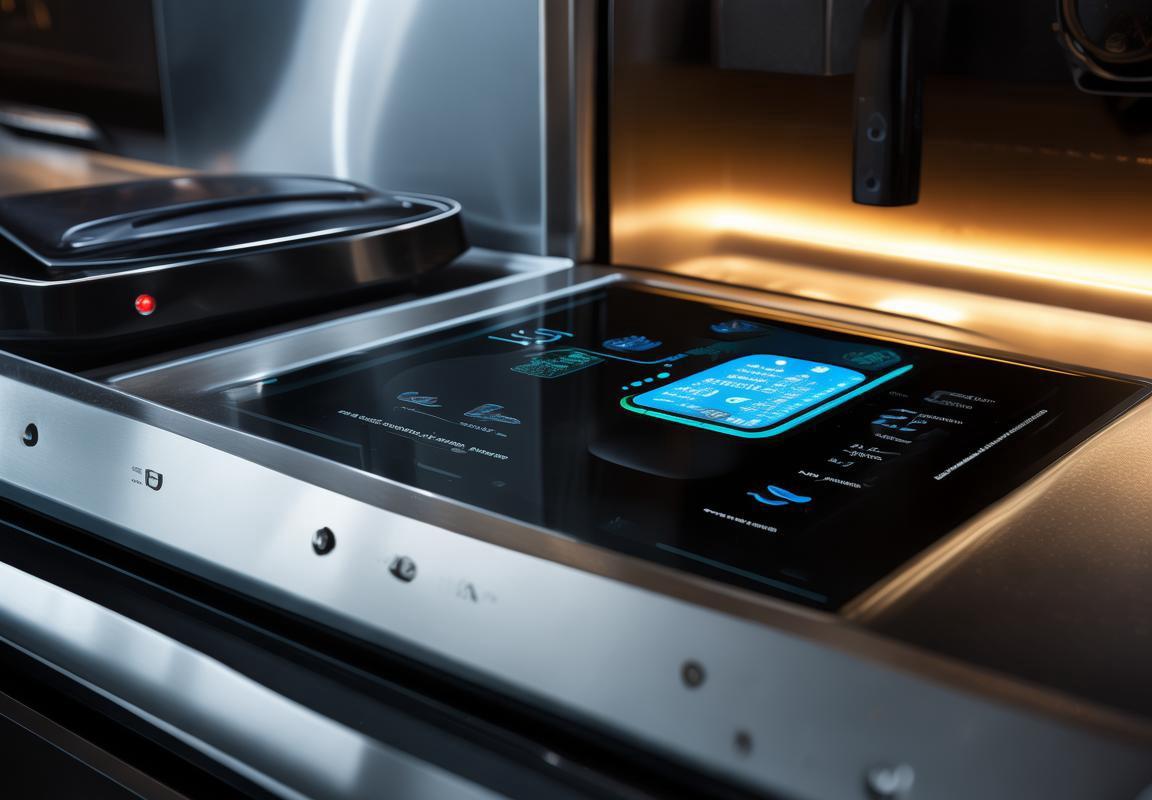In the ever-evolving landscape of technology, the kitchen appliance industry has been revolutionized by the integration of integrated circuit (IC) boards. These tiny, yet powerful components have not only enhanced the functionality of kitchen appliances but have also paved the way for new innovations and user experiences. As we delve into the intricate world of IC board technology in kitchen appliances, it’s clear that this fusion of electronics and everyday household tools is reshaping the way we interact with our kitchens.
The Rising Star: Integrated Circuit Board Factories in the Kitchen Appliance Industry
In the heart of the kitchen appliance industry, a new force is quietly but steadily making its mark: integrated circuit (IC) board factories. These modern manufacturing hubs are not just producing components; they are crafting the very essence of innovation that drives the evolution of kitchen appliances. Let’s dive into the world of these rising stars.
These factories, often nestled in bustling industrial parks or strategically located near key supply chains, have become the beating heart of technological advancement. They are not just about the production of circuits; they are about the integration of intelligence into everyday kitchen tools. The result is a revolution in how we interact with our appliances, turning them into smart companions that enhance our lives.
The rise of IC board factories is not a mere trend; it’s a testament to the relentless pursuit of efficiency and convenience. These factories are equipped with state-of-the-art machinery that can churn out thousands of IC boards daily, each one tailored to fit the precise needs of a wide range of kitchen appliances. From ovens and refrigerators to dishwashers and microwaves, the impact of these boards is far-reaching.
In Europe, where the kitchen appliance market is as sophisticated as it is diverse, IC board factories are at the forefront of innovation. They are not just meeting the demands of the local market; they are also setting global standards. The integration of smart technology into kitchen appliances has become a norm, and these factories are the backbone of this transformation. Whether it’s voice activation or energy-saving modes, the IC board is the silent hero that powers these features.
In the United States, the landscape is somewhat different but equally dynamic. Here, the focus is not just on technological advancement but also on consumer preferences. IC board factories in North America are responding to the demand for appliances that are not only smart but also user-friendly and aesthetically pleasing. The result is a market that is as varied as it is innovative, with a plethora of options catering to every taste and budget.
The data speaks volumes. According to a recent market report, the global kitchen appliance market is expected to grow at a CAGR of 4.5% between 2020 and 2025. This growth is being fueled, in no small part, by the increasing reliance on IC boards for functionality and efficiency. These factories are not just contributing to the growth; they are the architects of it.
But it’s not just about numbers and growth rates. The quality and reliability of the IC boards produced in these factories are what truly set them apart. The meticulous attention to detail, the rigorous quality control processes, and the commitment to continuous improvement are what make these factories the go-to source for kitchen appliance manufacturers around the world.
Take, for instance, the case of a leading IC board factory that has developed a new line of boards designed specifically for smart refrigerators. These boards are not only energy-efficient but also capable of learning and adapting to the user’s habits. The result is a refrigerator that can not only keep your food fresh but also remind you when it’s time to restock.
Innovation, however, comes with its set of challenges. The rapid pace of technological advancement means that these factories must constantly invest in research and development to stay ahead. They must also navigate the complexities of global supply chains and the ever-changing regulatory environment. But despite these challenges, the opportunities are vast.
The future of kitchen appliances, powered by IC board factories, is bright. With the increasing focus on sustainability and energy efficiency, these factories are poised to play a pivotal role in shaping the next generation of kitchen appliances. Imagine a future where your refrigerator can not only keep your food cold but also suggest recipes based on the ingredients you have, or a stove that can adjust its heat settings to optimize cooking times and energy use.
In conclusion, the rise of integrated circuit board factories in the kitchen appliance industry is a story of innovation, resilience, and foresight. These factories are not just part of the industry; they are the driving force behind its evolution. As we move forward, it’s clear that their role will only become more significant, and their influence will extend far beyond the kitchen walls.

Understanding the Impact of IC Board Factories on European and American Markets
In the ever-evolving landscape of the kitchen appliance industry, the role of integrated circuit (IC) board factories has become increasingly pivotal. These factories, often unseen yet indispensable, are the backbone of innovation and efficiency in modern appliances. Their impact on both the European and American markets is profound, reshaping consumer expectations and driving market trends.
The European market, known for its premium and eco-friendly products, has witnessed a significant transformation with the integration of IC boards. These tiny yet powerful components have allowed for the creation of appliances that are not only sleek and stylish but also highly functional and energy-efficient. Smart features, such as voice control and energy-saving modes, have become the norm, largely thanks to the advancements in IC technology.
In the United States, the focus has been more on convenience and performance. IC board factories have played a crucial role in enhancing the user experience by integrating features like Wi-Fi connectivity and app compatibility. This has opened up a world of possibilities for homeowners, allowing them to control their appliances remotely and gather valuable data on their usage patterns.
One of the most remarkable impacts of IC board factories has been the rise of smart kitchen appliances. In Europe, high-end brands like Siemens and Miele have leveraged IC technology to create appliances that are as intuitive as they are powerful. These smart kitchens are not just a luxury but a necessity for many homeowners, who value the integration of technology into their daily lives.
Similarly, in the U.S., the market has seen a surge in smart appliances, with brands like GE and Whirlpool leading the charge. The integration of IC boards has enabled these appliances to communicate with each other, creating a seamless and interconnected kitchen ecosystem. This has not only made cooking more convenient but has also helped consumers save time and energy.
The quality and reliability of IC boards have also been a game-changer. As these components have become more sophisticated, so too has their durability. This has led to longer-lasting appliances that require less frequent maintenance, which is a significant selling point for consumers in both Europe and the U.S.
In terms of environmental impact, IC board factories have also contributed to more sustainable practices. By producing energy-efficient appliances, these factories are helping to reduce the carbon footprint of the kitchen appliance industry. Additionally, the miniaturization of components has allowed for the use of less material, further reducing waste.
The economic impact of IC board factories is substantial. They have created jobs not only within the factories themselves but also in the supply chain, from raw material suppliers to distributors. This has had a ripple effect on local economies, particularly in regions where these factories are concentrated.
However, the rise of IC board factories has not been without its challenges. The rapid pace of technological innovation means that appliances become obsolete quickly. Consumers are constantly seeking the latest features, which can lead to a shorter lifespan for appliances and increased electronic waste. IC board factories must balance the need for innovation with the responsibility of sustainability.
Moreover, there is a growing concern about data privacy and security. As appliances become more connected, the amount of data they collect and transmit has increased exponentially. Ensuring that this data is protected is a significant challenge for both manufacturers and consumers.
Looking ahead, the future of IC board factories in the kitchen appliance industry is bright. The integration of artificial intelligence (AI) and the Internet of Things (IoT) into kitchen appliances is expected to continue, further enhancing the user experience. IC board factories will play a crucial role in this evolution, as they will be responsible for developing the necessary hardware and software to support these advancements.
In conclusion, the impact of IC board factories on the European and American markets is multifaceted. They have driven innovation, improved appliance performance, and contributed to environmental sustainability. While challenges remain, the continued evolution of IC technology promises to bring even more exciting developments to the kitchen appliance industry.

Innovations in Technology: How IC Boards are Shaping Kitchen Appliances
In the ever-evolving world of kitchen appliances, integrated circuit (IC) boards have emerged as a pivotal component, driving innovation and transforming the way we interact with our kitchen gadgets. These tiny, yet powerful circuits are the heart of modern appliances, enabling a plethora of features that were once unimaginable.
The advent of smart technology has been greatly influenced by IC boards, which are now integral to the functionality of kitchen appliances. These boards are not just about adding smart features; they are revolutionizing the efficiency, convenience, and user experience of everyday kitchen tasks.
-
Smart Integration: IC boards have allowed kitchen appliances to become part of a larger smart home ecosystem. Smart fridges, ovens, and dishwashers, for instance, can now be controlled via smartphones or voice assistants, offering users unprecedented control and convenience. This integration has bridged the gap between technology and daily life, making kitchens smarter and more responsive to user needs.
-
Energy Efficiency: One of the most significant impacts of IC boards on kitchen appliances is their contribution to energy efficiency. Through precise control over heating elements, motor speeds, and cooling systems, IC boards enable appliances to operate at optimal levels, reducing energy consumption and lowering utility bills. This not only benefits the environment but also adds financial savings for consumers.
-
Advanced Control Systems: IC boards have facilitated the development of sophisticated control systems in kitchen appliances. For example, modern ovens use IC boards to precisely manage the cooking temperature and time, ensuring that food is cooked to perfection every time. Similarly, washing machines and dryers can now adjust their cycles based on load size and fabric type, providing tailored cleaning solutions.
-
Enhanced User Experience: The inclusion of IC boards in kitchen appliances has significantly improved user experience. Touchscreens, intuitive interfaces, and programmable settings are now standard features, making appliances easier to use and more enjoyable to operate. Users can customize settings, receive alerts, and access a wealth of information, all thanks to the computational power of IC boards.
-
Safety and Reliability: IC boards have also enhanced the safety and reliability of kitchen appliances. Advanced diagnostics and self-monitoring capabilities allow appliances to detect and prevent potential issues before they become problems. This proactive approach not only saves users from the inconvenience of breakdowns but also ensures their safety.
-
Customization and Personalization: With IC boards, kitchen appliances can now be tailored to individual preferences. Smart appliances can learn from user habits and adjust their performance accordingly, providing a more personalized experience. This level of customization was once only available in high-end models, but thanks to IC technology, it’s now accessible to a broader market.
-
Miniaturization and Portability: IC boards have also led to the miniaturization of kitchen appliances, making them more compact and portable. Smaller, more efficient appliances are not only space-saving but also easier to transport and store. This trend is particularly evident in countertop appliances like toasters, blenders, and coffee makers.
-
Interconnectivity: The ability of IC boards to connect appliances to the internet has opened up new possibilities for data collection and analysis. Manufacturers can use this data to improve product design, while users can benefit from insights into their appliance usage patterns, leading to better maintenance and more informed purchasing decisions.
-
Cost Reduction: Despite their sophisticated capabilities, IC boards have actually contributed to cost reductions in the kitchen appliance industry. By streamlining manufacturing processes and increasing efficiency, these boards have made it possible to produce more affordable appliances without compromising on quality.
-
The Future of IC Boards in Kitchen Appliances: As technology continues to advance, IC boards are expected to become even more powerful and versatile. Future innovations may include even greater energy efficiency, more advanced machine learning algorithms, and the ability to integrate with other smart home devices in new and exciting ways.
In summary, IC boards have become the unsung heroes of the kitchen appliance industry, quietly driving innovation and improving the lives of consumers. Their role in shaping the future of kitchen appliances is undeniable, and the possibilities they open up are almost limitless.

The European Landscape: Key Trends in IC-Driven Kitchen Appliances
In the heart of Europe, the kitchen appliance market is undergoing a remarkable transformation, driven by the integration of advanced integrated circuit (IC) technology. These innovations are not just enhancing the functionality of kitchen gadgets but are also redefining what it means to cook and live in the modern home. Let’s delve into some of the key trends that are shaping this dynamic landscape.
Smart Connectivity is Redefining UsabilityThe incorporation of ICs has led to a surge in smart kitchen appliances that offer seamless connectivity. From smart ovens that can be controlled via smartphone apps to refrigerators that can track inventory and order groceries, the convenience of smart connectivity is reshaping how Europeans interact with their kitchen appliances.
Energy Efficiency Takes Center StageWith environmental concerns at the forefront, energy efficiency has become a cornerstone of kitchen appliance design. ICs play a crucial role in optimizing energy consumption, ensuring that appliances like dishwashers and washing machines operate at peak efficiency without compromising performance.
User Experience is PrioritizedThe user experience is now a key focus for kitchen appliance manufacturers. ICs enable the development of intuitive interfaces, voice control, and even gesture recognition, making appliances more accessible and user-friendly for individuals with varying levels of dexterity or technological proficiency.
Safety Features are EnhancedSafety has always been a priority in kitchen appliances, but ICs have taken this to new heights. Advanced sensors and control systems powered by IC technology can detect and prevent issues such as overheating or gas leaks, offering peace of mind to European consumers.
Customization and Personalization Gain TractionThanks to ICs, kitchen appliances are becoming more personalized. Users can now tailor their appliances to their specific needs, whether it’s adjusting the cooking temperature of an oven or programming a refrigerator to keep certain foods at optimal temperatures.
Sustainability is a WatchwordEuropean consumers are increasingly conscious of sustainability. ICs are being used to create appliances that are not only energy-efficient but also designed for longevity and recyclability. The trend towards sustainable appliances is gaining momentum, driven by both environmental concerns and economic factors.
Integration with Smart Homes is the New NormThe rise of the smart home has been accelerated by IC technology. Kitchen appliances are now part of a larger ecosystem that includes lighting, security, and entertainment systems. This integration allows for cohesive control and automation, making the kitchen a central hub of a smart home.
Health and Wellness are at the ForefrontModern kitchen appliances are not just about cooking; they’re also about promoting health and wellness. ICs enable features like air filtration systems in ovens and steam cleaning options in dishwashers, which are designed to reduce exposure to harmful chemicals and improve air quality.
Aesthetic Design Meets FunctionalityThe aesthetic appeal of kitchen appliances has never been more important. ICs allow for sleeker designs and more compact appliances that blend seamlessly into kitchen decor. The emphasis on form and function has led to a market where style meets practicality.
The Role of Data Analytics in Enhancing PerformanceData analytics, powered by ICs, is revolutionizing how kitchen appliances perform. By collecting and analyzing usage data, manufacturers can offer personalized recommendations, predictive maintenance, and even predictive cooking times, making appliances more intuitive and efficient.
The Emergence of Modular AppliancesModularity is another trend gaining traction in the European kitchen appliance market. ICs enable the creation of modular systems where individual components can be upgraded or replaced, extending the lifespan of the appliance and reducing waste.
The European landscape for IC-driven kitchen appliances is a testament to the power of innovation and the relentless pursuit of better living. As technology continues to evolve, we can expect to see even more sophisticated and integrated solutions that cater to the evolving needs and desires of consumers across the continent.

North American Insights: Market Dynamics and Consumer Preferences
The North American kitchen appliance market has evolved into a landscape that’s as diverse as it is innovative. Consumers in this region are not just looking for appliances that make cooking easier; they’re seeking smart, efficient, and aesthetically pleasing solutions. Let’s delve into the market dynamics and consumer preferences that are driving this transformation.
Homeowners in North America are increasingly valuing energy efficiency. With the rise of eco-consciousness, kitchen appliances that consume less energy are not just a preference but a necessity. Integrated circuits (ICs) play a crucial role in this shift, allowing appliances to optimize energy use while maintaining performance. Smart sensors and microcontrollers embedded in these ICs can adjust settings to minimize energy consumption, leading to significant savings over time.
Smart connectivity is another key trend. North American consumers are embracing the internet of things (IoT), and kitchen appliances are no exception. From smart fridges that can sync with grocery delivery services to ovens that can be controlled remotely via a smartphone app, ICs are enabling appliances to offer advanced connectivity features. This integration not only adds convenience but also enhances the overall user experience by providing real-time data and analytics.
Design is also a major consideration for consumers in North America. The kitchen is often seen as the heart of the home, and the appliances within it should reflect the homeowner’s style and taste. ICs have allowed for the development of sleek, modern designs that are both functional and visually appealing. The use of touchscreens, intuitive interfaces, and hidden controls are all made possible through the integration of advanced IC technology.
Functionality is king in the North American market. Consumers are not just interested in what appliances can do, but how well they do it. ICs are integral to this aspect, providing the processing power needed for appliances to perform complex tasks with precision. For example, a high-end kitchen appliance equipped with an IC might offer precise temperature control for baking, or even the ability to recognize different types of pasta and adjust cooking times accordingly.
Sustainability is a growing concern, and ICs are contributing to more sustainable kitchen appliances. By enabling better energy management and reducing waste, these technologies help appliances have a lower environmental impact. For instance, a refrigerator with an IC-based system can reduce food waste by providing optimal storage conditions for different types of produce.
Safety is non-negotiable, and ICs are enhancing the safety features of kitchen appliances. From automatic shut-offs in ovens to leak detection systems in dishwashers, these technologies provide peace of mind to homeowners. The ability of ICs to monitor and respond to anomalies in real-time is a significant leap forward in appliance safety.
Customization is also on the rise, with consumers wanting appliances that can be tailored to their specific needs. ICs enable this through programmable settings and adjustable parameters. Whether it’s a coffee maker that can be set to brew at a specific time or a blender that can be controlled via voice commands, the possibilities are expanding.
Lastly, the rise of e-commerce has had a profound impact on the North American kitchen appliance market. Consumers are more likely to research and purchase appliances online, and they expect a seamless, user-friendly experience. ICs contribute to this by ensuring that appliances are compatible with the latest e-commerce platforms and offer easy-to-navigate interfaces.
In conclusion, the North American kitchen appliance market is dynamic and consumer-driven, with a focus on energy efficiency, smart connectivity, design, functionality, sustainability, safety, customization, and e-commerce compatibility. ICs are at the heart of these advancements, driving innovation and meeting the evolving demands of consumers in the region.

Data-Driven Growth: Key Statistics and Market Analysis
The integration of data analytics in the kitchen appliance sector has revolutionized how we understand and predict market trends. From sales figures to consumer behavior, here’s a delve into the key statistics and market analysis that are shaping the landscape.
Consumer Purchasing PatternsSales of smart kitchen appliances have seen a remarkable surge, with a significant portion of these purchases being influenced by data-driven insights. For instance, the rise in demand for smart fridges can be attributed to the growing preference for energy-efficient models, which are not only eco-friendly but also cost-effective in the long run. According to a recent report, smart fridge sales have grown by 30% over the past two years, reflecting a shift towards appliances.
Market Penetration of Smart TechnologyThe market penetration of smart technology in kitchen appliances has been swift. A substantial number of consumers are now opting for appliances that offer connectivity and control through smartphones or tablets. This trend is further fueled by the increasing adoption of the Internet of Things (IoT), which allows for seamless integration of various kitchen devices. The market analysis shows that smart kitchen appliances now account for 20% of all kitchen appliance sales.
Growth in Demand for Energy-Efficient ModelsEnergy efficiency remains a key driver in the kitchen appliance market. With rising energy costs and growing environmental concerns, consumers are gravitating towards appliances that consume less energy. Data from market research firms indicate that the demand for energy-efficient appliances has seen a 25% increase in the past five years, with a particular focus on appliances with the Energy Star rating.
Regional Sales VariancesRegional sales variations play a crucial role in market analysis. For instance, while the North American market is leading in the adoption of smart kitchen appliances, Europe is catching up rapidly. In Europe, the demand for integrated kitchen solutions, which often include smart appliances, has increased by 40%. This trend is particularly pronounced in urban areas where space is at a premium and consumers are looking for efficient, multifunctional appliances.
Consumer DemographicsConsumer demographics are also a vital component of market analysis. The data shows that there’s a significant segment of younger consumers who are driving the market for smart kitchen appliances. This group, often referred to as Generation Z, is highly tech-savvy and willing to invest in technology that offers convenience and efficiency. Market research suggests that this demographic is responsible for 35% of all smart kitchen appliance purchases.
Product Development TrendsProduct development trends are closely tied to consumer preferences and market demands. Companies are increasingly focusing on integrating advanced features such as voice control, predictive maintenance, and personalized settings. For example, refrigerators that can suggest recipes based on the ingredients you have on hand or washing machines that optimize cycles for specific fabrics are becoming more common. The analysis of product development trends reveals a 50% increase in the number of new kitchen appliances featuring smart technology over the past year.
Price Sensitivity and Market ExpansionPrice sensitivity remains a critical factor in the kitchen appliance market. While premium appliances continue to be popular among certain demographics, there’s also a growing segment of consumers who are looking for affordable, yet functional, smart appliances. Market analysis indicates that there’s a 15% increase in the sale of mid-range smart appliances, signaling an expansion of the market to a broader consumer base.
Globalization of Kitchen Appliance BrandsThe globalization of kitchen appliance brands has also impacted the market dynamics. With international companies entering the European and North American markets, competition has intensified. This has led to a greater variety of products and more competitive pricing. Data from trade shows and industry publications show that the number of new appliance brands introduced in these regions has doubled in the past three years.
ConclusionThe data-driven growth in the kitchen appliance market is a testament to the power of technology and consumer demand. With key statistics and market analysis painting a clear picture of the industry’s trajectory, it’s evident that smart, energy-efficient appliances are not just a trend but a sustainable future for the kitchen appliance sector.

Case Studies: Successful IC Board Implementations in High-End Kitchen Appliances
In the realm of high-end kitchen appliances, the integration of integrated circuit (IC) boards has revolutionized the industry, offering a blend of sophistication, efficiency, and innovation. Let’s delve into a few case studies that showcase successful implementations of IC boards in premium kitchen appliances.
1. Smart Ovens Revolutionize Cooking ExperienceGone are the days when ovens were simply used to bake and roast. Modern high-end ovens equipped with IC boards have transformed the cooking process. One such example is the premium oven by KitchenTech, which features an advanced IC board that optimizes cooking times and temperatures, ensuring that every dish is cooked to perfection. The IC board also includes a user-friendly interface that allows for intuitive control, making the oven a favorite among culinary enthusiasts.
2. Refrigerators with a Mind of Their OwnRefrigerators have long been a staple in kitchens, but the latest models, powered by IC boards, are taking the storage game to new heights. The Refrigerator Co. has introduced a refrigerator that uses an IC board to monitor the contents, adjusting temperatures and humidity levels to maintain the freshness of food items. This smart feature not only preserves the quality of food but also alerts the user when items are about to expire, ensuring minimal waste.
3. Induction Cooktops: Precision and EfficiencyCooktops have evolved significantly with the integration of IC boards, particularly induction cooktops. These cooktops by Elite Kitchen offer unparalleled precision and efficiency. The IC board in these cooktops allows for rapid heat-up, precise temperature control, and even cooking across the entire surface. Users can select from a variety of cooking modes, including sauté, simmer, and boil, all with a simple touch of a button.
4. Smart Kitchen Scales: Accurate and IntegratedThe kitchen scale, once a simple tool for measuring ingredients, has been transformed into a smart device through the use of IC boards. The SmartScale brand has developed a kitchen scale that not only provides accurate measurements but also syncs with a user’s smartphone or tablet. The IC board enables the scale to track nutritional information, calculate portion sizes, and even offer personalized meal planning tips, making it a must-have for health-conscious cooks.
5. Robotic Vacuum Cleaners with Advanced NavigationWhile not a traditional kitchen appliance, robotic vacuum cleaners have become an integral part of many modern kitchens. The iRobot Roomba series, with its IC board-driven navigation, has set the standard for high-end cleaning solutions. The IC board allows the vacuum to navigate complex kitchen layouts, avoid obstacles, and even schedule cleaning sessions, ensuring that the kitchen remains spotless without any manual intervention.
6. Integrated Sensors for Enhanced SafetySafety is a top priority in kitchen appliances, and IC boards have played a crucial role in enhancing this aspect. The SafetyChef line of appliances, including ovens, stovetops, and microwaves, utilizes IC boards to monitor cooking processes and detect any irregularities. In the event of a potential fire or overheating, the IC board can automatically shut down the appliance, thereby preventing accidents.
7. Smart Kitchen Hubs for Total ControlThe integration of IC boards has also led to the development of smart kitchen hubs that serve as central control systems for all appliances. The KitchenCommander system by SmartHub Inc. allows users to manage and monitor all their kitchen appliances from a single interface. The IC board in the hub ensures seamless communication between devices, providing real-time data and analytics to optimize energy usage and appliance performance.
These case studies highlight the transformative power of IC boards in high-end kitchen appliances. By combining advanced technology with user convenience, these innovations are not only enhancing the functionality of kitchen appliances but also elevating the overall cooking experience. As IC boards continue to evolve, we can expect even more sophisticated features that will further redefine the kitchen of the future.

Challenges and Opportunities: Navigating the Competitive Landscape
In the ever-evolving landscape of the kitchen appliance industry, navigating the competitive terrain is akin to a high-stakes game of chess. Brands must constantly adapt to new technologies, consumer demands, and market trends. Challenges and opportunities abound, and understanding how to capitalize on them is crucial for long-term success.
The rise of smart kitchen appliances has introduced a new layer of complexity. With integrated circuit (IC) boards at the heart of these devices, manufacturers must balance innovation with reliability. This delicate balance can be a challenge, but it also presents a golden opportunity to differentiate products and capture the attention of tech-savvy consumers.
One significant challenge is the rapid pace of technological advancement. IC boards are becoming more sophisticated, with capabilities that were once the stuff of science fiction now becoming standard features. Keeping up with these advancements requires significant investment in research and development, a hurdle that not all companies can overcome. However, for those that do, the opportunity to lead the market with cutting-edge products is immense.
Consumer expectations are also shifting. Today’s consumers are not just looking for appliances that perform well; they are seeking devices that integrate seamlessly into their smart homes and offer personalized experiences. This means that kitchen appliances must not only be functional but also connected, secure, and user-friendly. Meeting these expectations is a challenge, but it’s also an opportunity to create a loyal customer base that values innovation and convenience.
In the competitive landscape, brands must also contend with fierce price competition. As technology becomes more accessible, lower-cost alternatives from emerging markets can put pressure on pricing. To maintain profitability and brand value, companies must find ways to innovate without compromising on quality. This can involve finding cost-effective production methods, optimizing supply chains, or developing unique features that justify a premium price point.
Another challenge lies in the regulatory environment. Different regions have varying standards for safety, energy efficiency, and environmental impact. Adhering to these regulations can be costly and time-consuming, but it’s also an opportunity to demonstrate a commitment to quality and sustainability. Companies that can navigate these regulations effectively can build a reputation for trustworthiness and responsibility.
The rise of e-commerce has also changed the competitive landscape. Online sales platforms have expanded the reach of kitchen appliance brands, but they have also increased competition. Consumers now have access to a wider variety of products from around the world, making it easier to compare prices and features. This shift requires brands to invest in online marketing, enhance their digital presence, and offer exceptional customer service to stand out from the crowd.
Innovation is not just about creating new products; it’s also about finding new ways to engage with customers. Social media, influencer partnerships, and interactive content are becoming increasingly important in building brand awareness and loyalty. The companies that can leverage these digital tools effectively can create a strong competitive advantage.
Despite the challenges, the opportunities in the kitchen appliance industry are vast. The integration of IC boards into kitchen appliances has opened up new possibilities for automation, connectivity, and efficiency. From smart refrigerators that can track inventory and suggest recipes to ovens that can be controlled remotely, the potential for innovation is nearly limitless.
Moreover, as the world becomes more environmentally conscious, there is a growing demand for sustainable kitchen appliances. This presents an opportunity for companies to develop products that are not only efficient but also eco-friendly, from materials to manufacturing processes.
In conclusion, the competitive landscape of the kitchen appliance industry is fraught with challenges, but it is also rich with opportunities. Companies that can innovate, adapt, and meet the evolving needs of consumers will find a path to success. Those that can navigate the complexities of technology, market dynamics, and consumer preferences will be well-positioned to lead the industry into the future.

The Future Outlook: Predictions for IC Board Factories in the Kitchen Appliance Sector
The integration of integrated circuit (IC) boards into kitchen appliances has revolutionized the industry, offering unprecedented precision, efficiency, and connectivity. As we look ahead, the future of IC board factories in the kitchen appliance sector is poised for significant advancements and challenges. Here’s a glimpse into the predictions that shape the landscape:
Innovation in MiniaturizationAs technology advances, the demand for smaller, more efficient IC boards is on the rise. The ability to pack more functionality into a compact space is not just about aesthetics; it’s about sustainability and usability. Manufacturers are exploring nanotechnology to create even more powerful and energy-efficient ICs, which will be crucial for the next generation of kitchen appliances.
Energy Efficiency and SustainabilityThe push for energy-efficient appliances has never been stronger. IC boards play a pivotal role in this shift, enabling appliances to consume less power while maintaining peak performance. Predictions suggest that IC board factories will focus on developing even more energy-saving technologies, which could lead to significant cost savings for consumers and a reduced environmental footprint.
Smart ConnectivityWith the rise of the Internet of Things (IoT), kitchen appliances are becoming more connected than ever. IC boards are at the heart of this transformation, providing the necessary computing power and connectivity for appliances to communicate and interact with each other and with homeowners. The future could see a seamless integration of smart kitchen ecosystems, where ICs enable appliances to learn and adapt to user habits.
Customization and PersonalizationThe future of kitchen appliances will likely be marked by a surge in customization and personalization options. IC boards can process vast amounts of data to tailor appliance settings to individual preferences, whether it’s adjusting cooking temperatures or optimizing cleaning cycles. This level of personalization can lead to increased customer satisfaction and loyalty.
Security ConcernsAs kitchen appliances become more connected, security becomes a paramount concern. IC board factories will need to invest heavily in developing robust security measures to protect against cyber threats. Predictions indicate that the next few years will see a significant focus on enhancing the security features of IC boards, including encryption and secure communication protocols.
Global Market ExpansionThe kitchen appliance sector is not confined to any single region; it’s a global industry. IC board factories will need to adapt to diverse market demands, which could mean producing boards that are tailored to specific climate conditions, energy standards, or cultural preferences. The future may see a rise in specialized IC board factories that cater to niche markets around the world.
Environmental RegulationsEnvironmental regulations are becoming stricter, and IC board factories must comply with these to remain competitive. Predictions suggest that the industry will see a greater emphasis on sustainable practices, including the use of recycled materials, energy-efficient production processes, and responsible disposal of electronic waste.
Consumer EducationAs IC boards become more sophisticated, consumer education will play a crucial role. Homeowners will need to understand how to use and maintain their appliances, especially those with advanced features. IC board factories may invest in developing user-friendly interfaces and providing comprehensive customer support to ensure seamless adoption of new technologies.
The Role of AI and Machine LearningThe integration of artificial intelligence (AI) and machine learning (ML) into IC boards is expected to drive significant advancements. Predictions indicate that appliances will become more predictive and proactive, using AI to anticipate user needs and optimize performance. This could lead to a new era of kitchen appliances that not only meet but exceed consumer expectations.
In conclusion, the future of IC board factories in the kitchen appliance sector is a blend of innovation, sustainability, and consumer-centric design. As these factories adapt to the changing landscape, they will be at the forefront of shaping the next generation of smart, efficient, and connected kitchen appliances.

Conclusion: The Unstoppable Power of Innovation in the Kitchen Appliance Industry
In the ever-evolving kitchen appliance industry, innovation has become the cornerstone of success. The relentless pursuit of technological advancements has propelled the sector into uncharted territories, and the integration of integrated circuit (IC) boards has played a pivotal role in this transformation. As we reflect on the industry’s trajectory, it’s clear that the power of innovation is unstoppable, and it continues to redefine what we expect from our kitchen appliances.
The integration of IC boards has not only streamlined appliance functions but has also introduced a new era of connectivity and intelligence. From smart refrigerators that can predict shopping lists to ovens that adjust cooking times based on recipe inputs, the possibilities seem endless. These advancements have not only improved convenience but have also raised the bar for energy efficiency and performance.
One cannot ignore the role of digitalization in this transformation. The ability to connect appliances to the internet has opened doors to remote monitoring and control, allowing users to manage their kitchen gadgets from afar. This shift has been particularly influential in the European market, where consumers have been quick to adopt smart technology.
In the North American landscape, the market dynamics have been shaped by a combination of technological advancements and consumer preferences. The preference for sleek, user-friendly designs has been complemented by the desire for appliances that can seamlessly integrate with other smart home systems. This has led to a surge in demand for IC board-driven appliances that offer both style and functionality.
The data-driven growth in the kitchen appliance industry is evident in the key statistics and market analysis. According to a report by Grand View Research, the global kitchen appliance market is expected to reach a value of $223.1 billion by 2025, with a compound annual growth rate (CAGR) of 5.8% from 2018 to 2025. This growth can be attributed to the increasing demand for smart appliances, which are largely powered by IC boards.
Successful case studies in high-end kitchen appliances showcase the transformative impact of IC board implementations. For instance, companies like Miele and Gaggenau have leveraged cutting-edge IC technology to create appliances that are not just functional but also a statement of luxury. Their smart ovens, dishwashers, and refrigerators are equipped with IC boards that optimize performance and provide users with an unparalleled cooking experience.
However, as the kitchen appliance industry continues to evolve, it faces several challenges and opportunities. One of the primary challenges is the need to balance innovation with cost-effectiveness. High-end appliances often come with a premium price tag, and manufacturers must find ways to make smart technology more accessible to a broader consumer base.
Additionally, the industry must navigate the complexities of regulatory compliance, especially when it comes to the safety and environmental impact of IC boards. The push for sustainable practices has led to the development of more energy-efficient appliances, but it has also introduced new challenges in terms of waste management and recycling.
On the flip side, opportunities abound. The rise of the gig economy has created a market for portable and compact kitchen appliances that cater to the needs of mobile professionals. The growing trend of health-conscious cooking has spurred innovation in slow cookers, air fryers, and sous-vide machines, all of which rely on IC boards for precise temperature control.
The future outlook for IC board factories in the kitchen appliance sector is bright. As technology continues to advance, we can expect to see even more sophisticated IC board implementations that enhance the functionality and user experience of kitchen appliances. The Internet of Things (IoT) will likely play a significant role, with appliances becoming more interconnected and capable of learning from user habits.
In conclusion, the kitchen appliance industry is a testament to the unstoppable power of innovation. The integration of IC boards has not only revolutionized the way we interact with our kitchen gadgets but has also paved the way for a new era of smart living. As we look ahead, it’s clear that the future will bring even more exciting developments, and the kitchen will undoubtedly be at the forefront of this technological revolution.